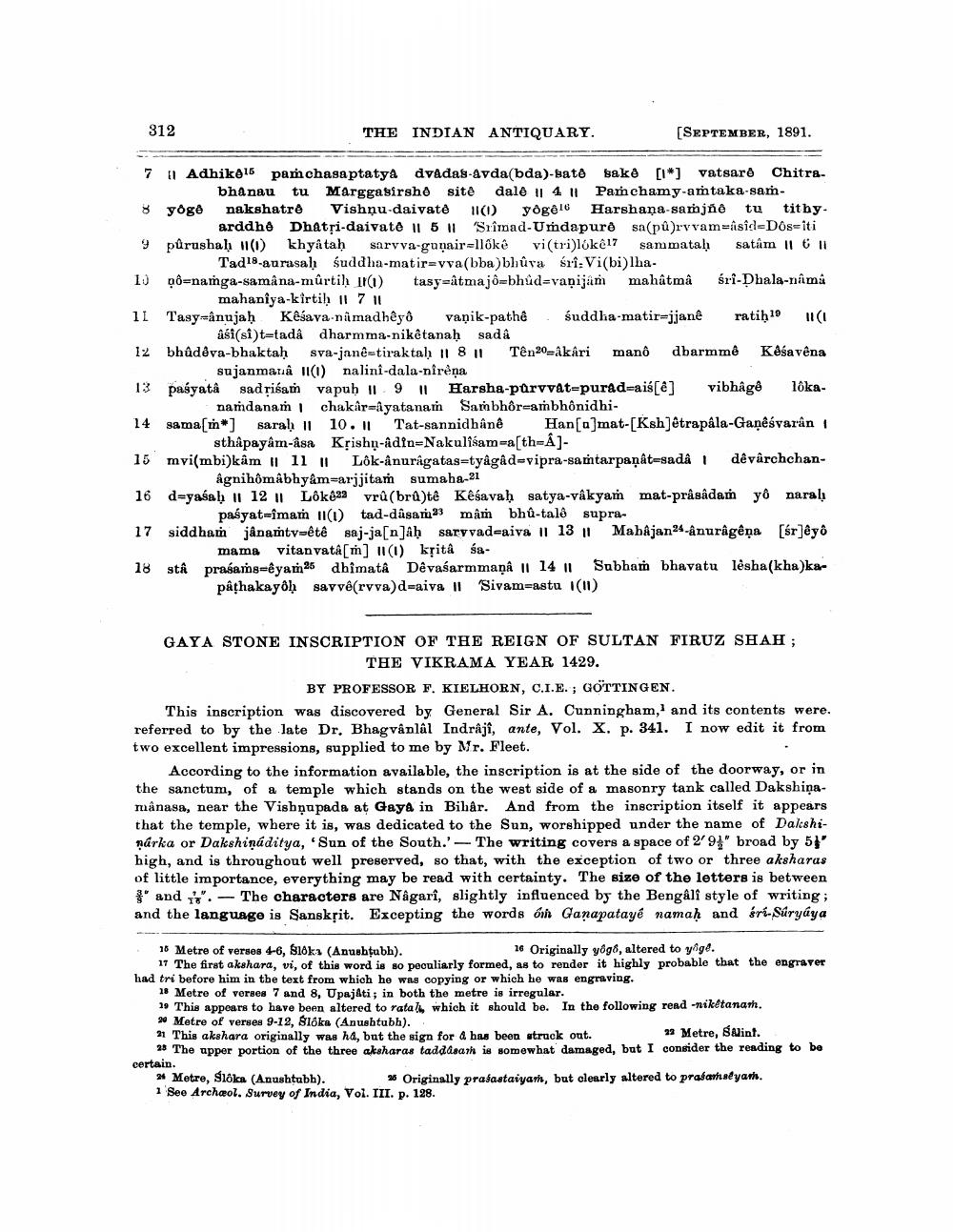________________
312
10
THE INDIAN ANTIQUARY.
7 || Adhikė15 pamchasaptatyå dvâdas-avda(bda)-Batô sakė [*] vatsarê Chitrabhanau tu Marggasirshê sitê dalê | 4 | Pamchamy-amtaka-sam
8 yogê
nakshatrê Vishnu-daivatė 11(1) yogêle Harshana-samjñê tu tithyarddhê Dhatṛi-daivate | 5 | Srimad-Umdapurê sa(pû)rvvam=âsîd=Dôs=iti 9 pûrushaḥ (1) khyâtaḥ sarvva-gunair-llôkê vi(tri)lókê17 sammataḥ satama || 6 || Tad18-aurasaḥ śuddha-matir-vva(bba)bhûva śrî: Vi(bi)lhapô-namga-samâna-mûrtiḥ (1) tasy-âtmajô-bhud-vanijam mahâtmâ
śrî-Dhala-nâmi
mahaniya-kirtiḥ 117 11
11 Tasy-ânujaḥ Kêśava-namadhêyo vanik-pathê śuddha-matir-jjanê ratiḥ 19 11(1 âśi(si)t-tadâ dharmma-nikêtanaḥ sadâ
12 bhûdêva-bhaktaḥ sva-janê-tiraktal 11 8 11 Tên20=dkari man dbarmmê Kêśavêna sujanmanâ (1) nalini-dala-nîrêņa
13 pasyata sadrisam vapuh II 9 || Harsha-pûrvvat-purad-aiś[ê]
vibhāg lôka
namdanam chakâr-âyatanam Sambhôr-ambhônidhi
[SEPTEMBER, 1891.
14 sama[m] sarah 1 10. I Tat-sannidhânê Han[a]mat-[Ksh]êtrapâla-Ganêśvarân sthâpayâm-âsa Krishn-âdin-Nakulisam=a[th=Â]
15 mvi(mbi)kâm || 11 || Lôk-ânurâgatas-tyâgâd-vipra-samtarpanât-sadâ | dêvârchchanâgnihômâbhyâm-arjjitam sumaha-21
16 d=yaśaḥ || 12 || Lôkê22 vrû (brû)tê Kêśavaḥ satya-vakyam mat-prâsâdam yô naralı pasyat-îmam (1) tad-dâsam23 mâm bhû-talê supra17 siddham jânamtv-êtê saj-ja[n]âh sarvvad-aiva || 13 ||
mama vitanvatâ [m] (1) kritâ sa18 stâ prasams-êyam25 dhimatâ Dêvaśarmmanâ | 14 |
pathakayoh savvê(rvva) d=aiva II Sivam astu I(11)
GAYA STONE INSCRIPTION OF THE REIGN OF SULTAN FIRUZ SHAH; THE VIKRAMA YEAR 1429.
―
Mahajan-ânurâgêņa [śr]êyô
Subham bhavatu lêsha (kha)ka
BY PROFESSOR F. KIELHORN, C.I.E.; GOTTINGEN.
This inscription was discovered by General Sir A. Cunningham, and its contents were. referred to by the late Dr. Bhagvânlâl Indrâjî, ante, Vol. X. p. 341. I now edit it from two excellent impressions, supplied to me by Mr. Fleet.
According to the information available, the inscription is at the side of the doorway, or in the sanctum, of a temple which stands on the west side of a masonry tank called Dakshinamânasa, near the Vishnupada at Gaya in Bihar. And from the inscription itself it appears that the temple, where it is, was dedicated to the Sun, worshipped under the name of Dakshinárka or Dakshinaditya, 'Sun of the South.'- The writing covers a space of 2′ 94" broad by 5" high, and is throughout well preserved, so that, with the exception of two or three aksharas of little importance, everything may be read with certainty. The size of the letters is between "and". The characters are Nâgarî, slightly influenced by the Bengâlî style of writing; and the language is Sanskrit. Excepting the words om Ganapatayé namaḥ and śri-Suryaya
15 Metre of verses 4-6, Sloka (Anushțubh).
16 Originally yogs, altered to yige.
17 The first akshara, vi, of this word is so peculiarly formed, as to render it highly probable that the engraver had tri before him in the text from which he was copying or which he was engraving.
18 Metre of verses 7 and 8, Upajâti; in both the metre is irregular.
19 This appears to have been altered to ratal, which it should be. In the following read -niketanam.
20 Metre of verses 9-12, Sloka (Anushtubh).
24 Metre, Sloka (Anushtubh).
1 See Archæol. Survey of India, Vol. III. p. 128.
21 This akshara originally was hd, but the sign for & has been struck out.
22 Metre, Saint.
25 The upper portion of the three aksharas taddasath is somewhat damaged, but I consider the reading to be certain.
26 Originally prasastaiyam, but clearly altered to prasamatyam.




